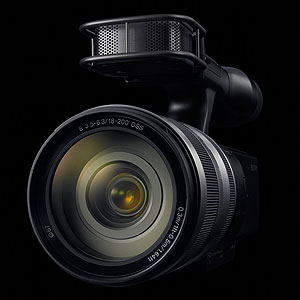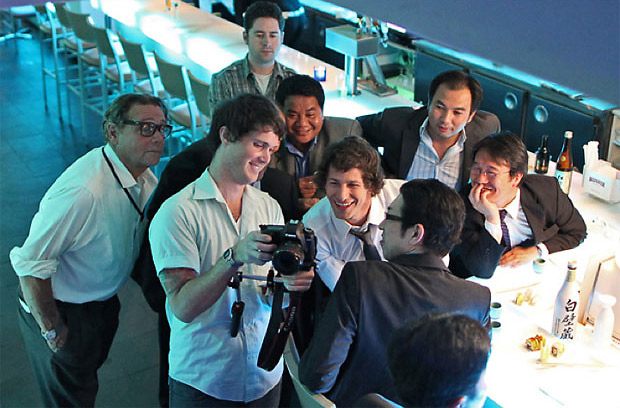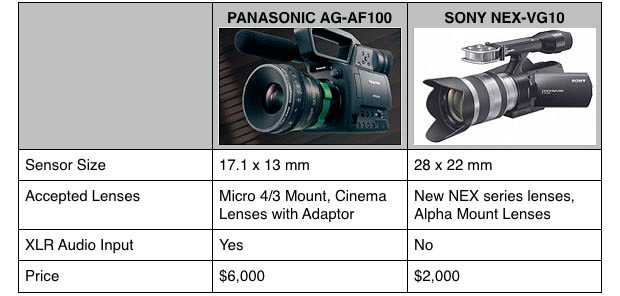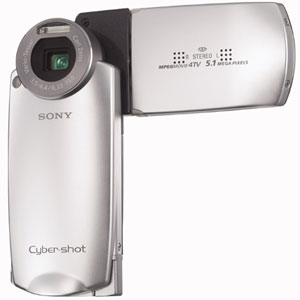Sony NEX-VG10 vs. Panasonic AG-AF100
Two new DSLR-inspired, consumer-influenced video cameras


Over the last year, droves of filmmakers have been ditching traditional video cameras in favor of the stunningly rich images produced by the ultra-shallow depths of field, bigger sensors and interchangeable lenses of DSLRs with HD capabilities.
With the consumer-led phenomenon showing no signs of slowing, both Panasonic and Sony have taken notice, recently announcing models that build on the strengths of DSLRs by adding filmmaking-specific features. The new cameras incorporate all the favorable elements of DSLRs but add proper audio connections, autofocus and the ability to record long clips. Read on to learn more about how consumers changed the market, and how the two cameras measure up against each other.
Crowd Forcing
Thanks in no small part to social media, the impact that consumers can now make on manufacturers happens in impressively short time spans. No one understands this in the DSLR world better perhaps than Philip Bloom, whose site has attracted millions of hits since he began posting guides on how to use DSLRs for video. Now with over 14,000 followers on Twitter, wherever Bloom goes his followers find him for a chance to show off their gear and talk shop. As a great example of how social media gives people a voice that manufacturers can’t ignore, check out our quick interview (above) with Bloom while he was shooting recently in New York.


The Film Look
Since the advent of digital video, filmmakers have been obsessed with achieving the gorgeous play of light captured by 35mm film. One of the biggest signatures—a shallow depth of field resulting in textural detail—has until now been lacking. Just take a look at television, YouTube, family videos, or the image above right to see how typically almost all of the image is in focus.
Adopting the DSLR’s bigger sensor sizes are the main reason why these new video cameras will be able to get such a defined focus. The bigger chip (about four times bigger than the one in the commonly-used HVX) lets more light in and also improves a host of other features for a camera that ultimately has a more professional look.

Size Matters
The biggest limitation of video cameras has been small sensors, with most home video and broadcast camera chips at a fraction of the size of DSLR’s. When Canon made the decision in 2008 to allow their full-frame Canon 5D Mark II (used by photojournalists) to capture HD video, they accidentally started a revolution. Canon hired award-winning photojournalist Vincent Laforet to shoot a concept film with the Canon 5DMKII that went viral in the film world. Suddenly a $2,600 camera with a mega-sensor was available, and the resulting film-quality footage—considerably better than any video camera on the market—showed up in television programs like “Saturday Night Live” and “House.”

From HDSLR to Camcorder
The Canon, Panasonic and Nikon DSLRs that shoot video don’t have proper audio connections or autofocus and can’t record long clips. While Canon released video versions of their camera (an HDSLR) running from $900 to $5,000, filmmakers threw down a lot more cash to companies that make genuine audio recording devices, follow-focus systems and stabilizers to make cameras practical for video. While the Panasonic and Sony camcorders coming out late this year will cost more than the DSLRs, they will introduce better audio capabilities as well as autofocus to the format.

Camera vs. Camera
Final specs have yet to be officially released, but Sony’s NEX-VG10 will rival other high-quality home video cameras while Panasonic’s AG-AF100 makes a bid for the pro market. Using the chip from their small HDSLR camera the GH1, Panasonic builds off their proven form factor and udder interface that any filmmaker who shot with their DVX, HVX and HMC series cameras will find familiar. The ability to use Micro 4/3 mount and cinema lenses allows for a lot more flexibility than Sony’s NEX-VG10, which will only accept Sony lenses.
Another factor setting the Sony apart from professional cameras is the lack of professional audio inputs and video-out jacks. While it does have an elaborate four-microphone pod on the top of the camera, on-camera mics have been a problem because of internal electronics making noise—an issue offset with this camera since it records to a memory card.
Sony often mirrors their high-end consumer cameras with professional models however, so expect to see a version that also supports XLR audio inputs in the near future. Although not unique to Sony, MTV and other channels devoted to reality TV love Sony’s cheaper professional cameras for its lightweight and ease of use when following people around. So stay tuned for a professional version of their NEX-VG10 to support that demand too.











